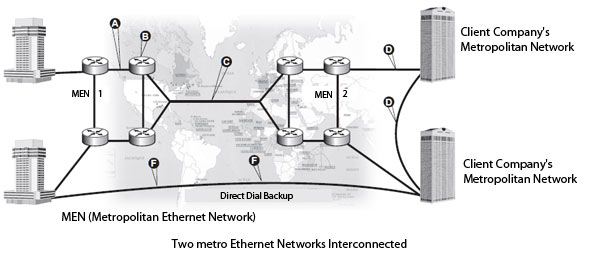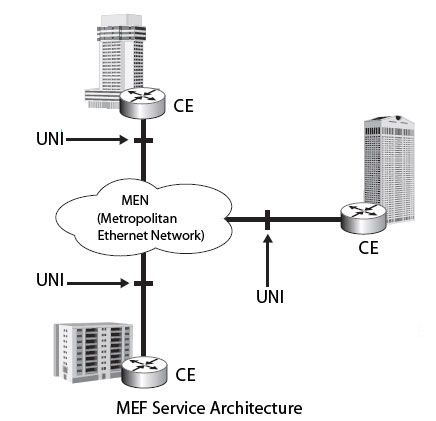After invading the world of business, Ethernet addresses the longer distances starting with the metropolitan area. The Metro Ethernet was born of this extension. This solution is supported in different settings but especially by the Forum MEF (Metro Ethernet Forum).
The figure shows two metro Ethernet networks connected by an Ethernet WAN (Wide Area Network).
In this scheme, the label A shows a communication line in the metro network which is the point-to-point switched using a GbE or 10GbE. The label describes a node B of the metro network which can be either GbE or 10GbE Ethernet switch or IP router very high speed. The choice is made depending on the connections that need to be managed on the node. If there is only a passage node, there is no incentive to go back to the IP layer. If it is a hub or acting as a gateway, it can be interesting to trace the IP level. The label C is a long distance line to connect two MAN networks together. The use of the Ethernet WAN is recommended if the nodes of MAN are Ethernet switches.

The label D indicates the connection of a company in the metro Ethernet network. This connection can be done either through an Ethernet point-to-point type “last mile” connection acting as the local loop, or through a multipoint IEEE 802.17 technology, also called Ethernet RPR (Resilient Packet Ring).
The label E indicates the possibility to set up secure connections of the network for reconfiguration in the event of failure of the core network. Such security can be carried out in point-to-point or end-to-end from node to node. F The label refers to any engineering to be implemented to achieve the communications, control and maintain them.
The number one goal of the MEF is to provide network services to companies in a metropolitan setting. MEF services can be illustrated as in Figure.

This figure shows the connection of companies with their own network CE (Customer Edge) through a UNI offering services mainly related to the flow rate, the transit time and the loss rate. The objective is to provide two or more UNI transfer service. An important first service implemented by the MEF is the EVC (Ethernet Virtual Connection). VCA can be point-to-point or multipoint. It allows for different types of services, from emulating a leased communication line to the equivalent of a virtual private network.
Flow control is carried out in a manner similar to DiffServ, which was developed by the IETF for the IP world. Three major classes of customers are defined, and Ethernet switches or IP routers must reflect these priorities. The quality of service is ensured statistically.
 Dinesh Thakur holds an B.C.A, MCDBA, MCSD certifications. Dinesh authors the hugely popular
Dinesh Thakur holds an B.C.A, MCDBA, MCSD certifications. Dinesh authors the hugely popular